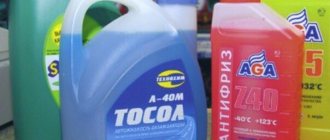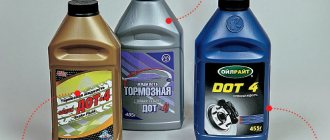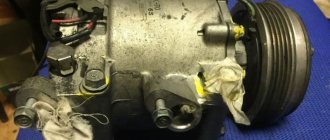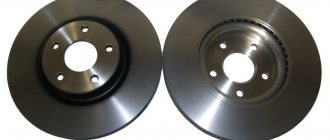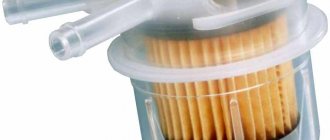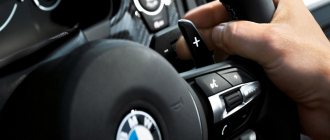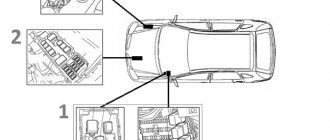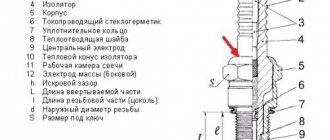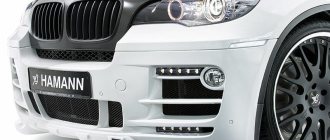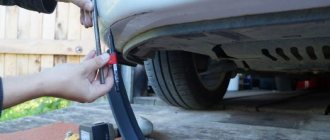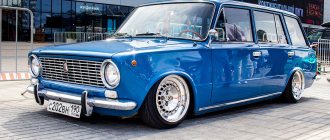What to pour Antifreeze or Antifreeze?
What is better - antifreeze or antifreeze ? Is it possible to mix them? How to choose the right coolant? These questions worry many novice car enthusiasts. Let's try to answer them and decide on the main question - what is better to fill, antifreeze or antifreeze ? Before moving on to the analysis, it is necessary to understand what coolant is, what it is needed for, and on what basis it is produced.
Characteristics of coolants
The task of any coolant (coolant) is to prevent the engine from overheating during operation. Previously, ordinary or distilled water was used in this capacity, but its use has a number of disadvantages, including:
- water will freeze in frost and boil at a temperature of +100°C , that is, it has a small operating temperature range;
- water negatively affects some elements of the engine cooling system, in particular, it exposes them to corrosion.
It was these shortcomings that once forced automakers to invent coolants based on a water-glycol composition. In the territory of the former USSR, the most popular coolants are liquids using ethylene glycol. In addition, to prevent corrosion of cooling system elements, anti-corrosion additives are added to the coolant. They come in two types:
- Silicate . Such compositions cover the inner surface of parts of the system with a small layer of scale. Due to this, the amount of thermal energy recirculation is reduced. As a rule, such coolants are green .
- Carboxylate . These compounds provide protection against corrosion in those places where it is most likely to occur by creating a protective layer. At the same time, carboxylate compounds have a longer service life, and when replacing coolant there is no need to flush the system. The color of such liquids is red .
This classification is the standard worldwide. However, at present, many manufacturers use various dyes in production, which make it difficult to identify a particular liquid.
Composition of antifreeze and antifreeze
Almost all coolants have the same base.
About 90-93% of the total volume is ethylene glycol + distilled water. In itself, such a compound gives good characteristics: the boiling point is about 150 degrees, freezing occurs at -40 degrees. The disadvantages of this composition include high aggressiveness towards the elements of the cooling system. The use of such a liquid without anti-corrosion additives leads to irreparable consequences (deformation of the cylinder block, failure of the pump and radiator, softening of pipes and lines).
In order to avoid negative consequences, additional additives are used, the composition and quantity of which classifies all antifreezes as follows.
Antifreeze - blue or red liquid
It dates back to the times of the USSR. Antifreeze is just an unpatented acronym that is widely used by many manufacturers.
The first three letters of TOS stand for technology of organic synthesis, the last two letters were added for consonance.
It is based on ethylene glycol and distilled water, and also adds a package of chemical additives (silicates, phosphates, borates, etc.), due to which the aggressiveness of the liquid is reduced.
How to determine the quality of antifreeze - video
In addition to cooling properties, antifreeze also has protective functions. With the help of an additive package, a protective layer several microns thick is formed inside the cylinder block, radiator and pipes, which prevents the formation of corrosion, but reduces the heat transfer of the engine.
In winter, this contributes to accelerated heating of the internal combustion engine and is a positive quality. But in summer it can cause the engine to overheat. The freezing point of antifreeze is -40 degrees if the liquid is blue and -65 if it is red. Boiling point +115 degrees.
The service life of Antifreeze under normal operating conditions is from two to three years. With longer use, sediment may form and the protective layer may be destroyed.
Antifreeze (G11)
Color blue or green. Produced by import organizations. G11 – marking according to the generally accepted classification proposed by the VAG concern.
It contains a glycol base and distilled water with an additional set of chemical additives. The main difference from antifreeze is the addition of organic matter (carboxylic acid). Actions aimed at preventing the development of corrosion foci.
The protective function is performed in a similar way with blue coolants. Freezing temperature - 40 degrees. Maximum operating + 130 degrees. Recommended replacement frequency is 5 years.
Red antifreeze (G12). Still the same base: ethylene glycol and distilled water. No chemical additives are used to produce this liquid. They were abandoned in favor of organic ones based on carboxylic acid.
The absence of a protective film on the internal elements of the cooling system increased heat transfer, which solved the problem of overheating in the summer. But it increased the formation of corrosion foci, which carboxylic acid combats quite effectively.
The disadvantage of this formula is that the protective functions of antifreeze appear only after a problem has formed. No preventative measures are taken with organic additives.
The operating temperature range is from -40 to +150 degrees. The service life of the G12 coolant is 5 years.
The secret is not in unique technology
It is impossible to take into account all the nuances within one article, just as it is impossible to start a business from scratch and never step on a rake. That is why it is not equipment that is in demand, but a turnkey business solution. If the quality of support is high, even people who are far from the automotive business can succeed on the first try.
Despite the simplicity of the technology, more than half of the contracts for the supply of equipment from Integrated Systems turned into regular customers. The secret is not technology. It’s just that the company’s main product is not machines, but the knowledge of how to get around the above-mentioned rake.
Antifreeze filling line - video
Antifreeze A-40 "Dzerzhinsky"
Characteristics of antifreeze a-40
This is a product from Novakhim LLC. It is a high-quality coolant based on ethylene glycol. The crystallization temperature is -40 degrees. The pH value is 8.10 pH. What is the density of antifreeze A-40? The table in GOST indicates a figure of 1.085 grams per cubic centimeter. In terms of fractional composition, Dzerzhinsky antifreeze also showed good characteristics. The boiling point is 105 degrees Celsius. And the proportion of liquid distilled at 150 degrees is 45 percent. As studies have shown, antifreeze A-40 “Dzerzhinsky” has the best performance characteristics among all of the above. But the cost of this product is much higher.
By the way, this company recently released another product - Siberia antifreeze. It is used in ODS of both diesel and gasoline engines. Can be used at temperatures from -40 to +115 degrees Celsius. The composition contains demineralized water, dye, as well as an additive package and ethylene glycol.
TOSOL - coolant for VAZ engines
History, composition and application of antifreeze
Replacing antifreeze on a VAZ 2107
Story:
TOSOL is a coolant made in Russia. The word TOSOL
comes from the abbreviated name “Organic Synthesis Technologies”. In 1971, this liquid was developed at the Research Institute of Organic Chemistry and Technology. The suffix “ol” was added to the abbreviation, which indicates that the liquid belongs to alcohols.
Initially, TOSOL-A was produced since 1989 only at state industrial enterprises in accordance with GOST using strict and proven technology. Nobody patented the name, and it became common for Russian and Ukrainian manufacturers of coolants
. Now TOSOL is made according to a completely different recipe.
Compound:
TOSOL consists of a glycol base and a package of additives. The boiling point of alcohol is about 200 C, the freezing point is -12 C. However, it is poisonous. TOSOL is 90% propyleglycol, only 5% is additives and a little more water.
Application:
TOSOL cools the engine from overheating. It does not freeze at temperatures from -30 to -65 degrees Celsius and does not boil at temperatures above +180 degrees. In addition to cooling functions, TOSOL lubricates the engine and prevents the formation of corrosion. It is mainly used for Soviet-made trucks, as well as for old models of Zhiguli and AVTOVAZ and GAZ cars.
Mandatory properties of TOSOL:
- Prevent corrosion
- Do not destroy rubber and plastic parts
- Do not foam
- Have low viscosity
Antifreeze color:
Sometimes TOSOLA is presented not only in blue. Initially it was painted blue or blue. Now it is painted green, red or yellow. Color helps determine the level of refrigerant in the system and immediately notice a leak of antifreeze
. The substances included in TOSOL (water, alcohol, additives) are colorless.
Service life: It is important to monitor the condition of antifreeze
in system. If it has acquired a reddish-brown color, then this is a sign of corrosion, which means it’s time to replace the antifreeze. Such coolant spoils the mechanism. The service life of TOSOL is from 1 to 3 years. AVTOVAZ itself advises replacing the coolant every two years, every 60,000 km.
There are three most popular brands of Antifreeze:
- A-35 - designed to operate at temperatures down to -35 degrees. This type of TOSOL is used in hot and warm regions. Contains ethylene glycol and anti-corrosion additives.
- A-40 is the most versatile coolant at a low cost. The characteristics of this coolant are ideal for the operation of engines in our country. Typically TOSOL-40 looks like a blue refrigerant.
- A-65 - red antifreeze
. The color indicates the level of coolant in the reservoir and helps to spot leaks. It is capable of operating at temperatures down to -65 degrees.
Designations in the name of TOSOL: A - automobile, M - modernized, 40/35/65 - the temperature at which the liquid crystallizes.
What is the difference between antifreeze and antifreeze?
Replacing antifreeze on a VAZ 2109
Both products are coolants that are poured into the engine cooling system in order for it to function properly at any temperature. The main property of such liquids is that their freezing point is much lower than that of water. But they also have differences that will be useful to know about.
Kinds
Antifreeze is the general name for any coolant, regardless of time and place of release.
Antifreeze is an analogue, only released in the USSR. In those days, there was no replacement for it, so the name of the brand became a household word and antifreeze was used to call any coolant, both domestic and foreign. In general, TOSOL is an abbreviation for “technology of organic synthesis of a separate laboratory.”
These types of antifreeze are used in the automotive industry:
- G Hybrid species, green in color. Provides protection against corrosion, maintains the integrity of the system pipes, enveloping the walls with a protective film. Suitable for passenger cars and aluminum parts;
- G Organic red product. A protective film is formed only in those places where rust has appeared. Suitable for truck engines. Extends the service life of brass and copper parts;
- G The most environmentally friendly product, orange in color. It is used to cool car and motorcycle engines.
Antifreeze, like antifreeze, also comes in several types:
- A – ready-to-use product;
- M – modernized, with additional components;
- K is a concentrate from which you make your own coolant.
Characteristics and properties
Inorganic salts can clog the radiator over time.
Antifreeze forms a protective film on the surface of metal parts, no more than 0.5 mm thick. But such protection has low heat transfer, which leads to increased fuel consumption and rapid engine wear.
It contains inorganic salts, which can cause the radiator to become clogged over time. The maximum operating temperature of antifreeze, until which its properties are maintained, is +105 degrees Celsius.
The composition contains organic salts, so no sediment is formed during operation. The boiling point is +115 degrees. The color of antifreeze does not matter - it is a dye that does not affect the capabilities of the liquid.
Compound
The basis for the production of antifreeze is ethylene glycol, glycerin, triethylene glycol or a mixture of them. The final composition depends on the manufacturer, but it also includes water, dyes and corrosion inhibitors. Additives – salts of inorganic acids (phosphates, silicates, nitrates, nitrites).
Letter designation G12
The basis of antifreeze is similar antifreeze agents, only organic additives are used. Modern liquid (“Lobrid”, with the letter designation G12++) is made on the basis of propylene glycol, as a more environmentally friendly substance.
Organic ones are better, as they have a beneficial effect on anti-cavitation, anti-corrosion and anti-foam properties.
Areas of use
Mark G12+
There are many different “anti-freeze” products available, therefore, choosing a liquid for a car of any brand, domestic or foreign, is not a difficult task.
As for antifreeze:
- G A product similar to antifreeze, suitable for cars manufactured before 1996. Not suitable for modern cars, as it worsens engine cooling;
- G Choice for high-speed, heat-loaded transport;
- G12+. For modern cars;
- G For high-performance engines (sports cars, motorcycles) operating under maximum loads.
Therefore, this coolant is chosen by those who drive old cars, usually domestic ones, where there is no point in caring for an already “tired” engine.
Life time
Antifreeze is a mineral “antifreeze” that can last 50,000 km (2 years). Organic antifreeze lasts longer - 250,000 km (5 years).
The passport for the liquid indicates how long you can drive on it. But, if the product has changed color or is completely discolored, it means that its protective properties have been lost and it’s time to replace it.
An unpleasant odor says the same thing. During the replacement, before pouring new fluid into the tank, the cooling system is washed with special products and water.
Antifreeze classes
Antifreezes are classified using the letter G and a number, by which one can judge its composition and properties. The forefather of this marking is the world-famous Volkswagen company, which at one time produced the popular brands of antifreeze “VW coolant G 11” and “VW coolant G 12”.
Thus, in accordance with the labeling adopted by Volkswagen, the following types of antifreeze are currently used:
Inhibitor content depending on mileage
- Silicate, designated as G11 (meets VW specification TL 774-C). By the way, the old Soviet “Tosol” also belongs to this type. The operating principle of the composition is to form a thin protective film that prevents corrosion of the cooling system elements. Volkswagen recommended it for cars of its own production until 1996. Typically, G11 fluids are green or blue in color. The liquids contain nitrates, amines, nitrites, borates, phosphates, and silicates.
- Carboxylate, designated G12 (meets VW specification TL 774-D). In Europe, G12 antifreezes are recommended for use in cars produced before 2001. Has a red or pink color.
- Hybrid, G12+ (complies with VW TL 774-F specification). Designed for high-speed engines with high temperature loads, used for cars manufactured in 1997...2008 (in our country they are also used for newer ones). Has a red color.
- “Lobrid” (Lobrid) . Has index G12++ (corresponds to VW TL 774-G specification) or G13 . In the latter case, propylene glycol is used as a base instead of ethylene glycol. Such antifreezes are non-toxic, quickly decompose and cause significantly less harm to the environment. However, their disadvantage is their high cost, so they are rarely used in the CIS countries. These antifreezes are recommended for use in cars manufactured in 2008 and later. It has an orange or yellow color.
It is worth noting separately that the majority of antifreezes sold on the domestic market do not meet the mentioned specifications from Volkswagen. In addition, in order to have an official license, antifreeze must be certified in the company’s laboratories. Naturally, 99% of liquids sold have not passed such a test. Therefore, the classification of antifreeze according to the G-parameter is very conditional, and should be treated with a grain of salt.
Types of antifreeze
Car owners can purchase both a concentrate, which will require subsequent dilution of the distillate, and liquids that are completely ready for use. From the antifreeze labeling you can obtain information about the freezing temperature, as well as the presence of a modernized formula that prevents the formation of corrosion and calcium deposits inside the engine.
Initially, buyers were offered only two classes of antifreeze:
- A-40.
- A-65.
However, subsequently, improved versions of the coolant were developed, which in their characteristics are not inferior to expensive antifreezes. Antifreeze, the decoding of which is not particularly difficult, may have different symbols. The presence of the M index in the name indicates a modernized formula and the use of various corrosion inhibitor additives, which make the use of such technical fluids completely safe for modern cars.
When operating a car in central Russia, where winter temperatures rarely drop below minus 30 degrees, standard antifreeze will be sufficient, which freezes at temperatures below 45 degrees. But in the north, where truly extreme frosts can occur, car owners prefer the A 65 M modification, which is able to maintain its performance characteristics over a wide temperature range.
Most car owners, in order to save money, purchase concentrates and dilute them with distilled water themselves, which can significantly reduce the cost of car servicing. To obtain coolant with a freezing point of -40 degrees, the concentrate is diluted with distilled water in a one-to-one ratio. If you need a solution with a freezing point of -30, then mix 3 parts water and 2 parts concentrate.
It is necessary to dilute concentrated antifreeze in a separate container and only then pour coolant into the expansion tank or radiator. You should not use ordinary tap water to dilute the concentrate, since antifreeze and the components it contains can separate when in contact with hard water, which contains magnesium and calcium salts. Only distilled water will provide a 100% guarantee against sediment formation.
Motor transport - rules, norms, regulations
Composition of antifreeze.
The antifreeze composition is prepared by mixing ethylene glycol with distilled water. The lowest freezing point (-75°C) is a mixture containing 66.7% ethylene glycol and 33.3% water. Due to the use of distilled water in mixtures, antifreezes do not form scale in the engine cooling system, which is one of their main advantages.
When antifreeze is heated during engine operation, water evaporates from it; ethylene glycol does not evaporate due to its high boiling point (195°C). Therefore, the loss of the mixture is compensated by adding distilled water to the cooling system.
Before adding water to the cooling system, as well as during vehicle operation at low temperatures, the antifreeze composition is checked with a hydrometer. A hydrometer is a type of hydrometer, but instead of a density scale there is a scale for the concentration of ethylene glycol in the mixture and the freezing point of the antifreeze. Each mixture composition has a specific density. Antifreeze density values are given in the table.
The industry produces pure ethylene glycol of the OZh-K brand (concentrate with a mass fraction of water of no more than 5%), water-ethylene glycol mixtures of the OZh-40 and OZh-65 brands with freezing temperatures of 40°C and 65°C, respectively, and antifreeze of the A and A-40 brands and A-65.
Antifreeze brand OZh-40 contains 53% ethylene glycol and 47% distilled water, brand OZh-65 – 65% ethylene glycol and 35% water. These antifreezes are intended for filling closed cooling systems without expansion tanks; cooling systems are filled 5-7% less than their volume; When spring arrives, the antifreeze is drained from the cooling system into clean containers and can be reused.
Antifreeze.
Low-freezing liquid "Tosol" is a water-ethylene glycol mixture with the addition of 2.5-3.0% of a complex composition of anti-corrosion and anti-foam additives. Antifreeze is used as an all-season coolant for passenger cars and certain brands of trucks.
Antifreeze A is concentrated ethylene glycol with additives (ethylene glycol content 96%, water no more than 3%). Antifreeze A should be used after diluting it with distilled water. A mixture of Antifreeze A and water in a 1:1 ratio has a freezing point of minus 35°C.
An aqueous solution of Antifreeze A with a freezing point of minus 40°C is labeled Antifreeze A-40, with a temperature of minus 65°C - Antifreeze A-65.
The composition of antifreeze and antifreeze, their density and other indicators are given in the table.
| Indicators | OZH-40 | OZH-65 | Antifreeze A | Antifreeze A-40 | Antifreeze A-65 |
| 1. Composition, % | |||||
| - ethylene glycol | 53 | 65 | 96 | 55 | 64 |
| - distilled water | 47 | 35 | no more than 3.0 | 43 | 34 |
| - additives | — | — | no more than 3.0 | no more than 3.0 | no more than 3.0 |
| 2. Density, g/cm3 at 20°C | 1,067-1,072 | 1,085-1,090 | 1,12-1,14 | 1,078-1,085 | 1,085-1,095 |
| 3. Freezing temperature, °C | -40 | -65 | -21,5 | -40 | -65 |
| 4. Appearance | Light yellow liquid | Orange liquid | Blue-green liquid without mechanical impurities | Blue-green liquid without mechanical impurities | Blue-green liquid without mechanical impurities |
What types exist
Antifreeze is the general name for all coolants. There is a huge variety of them. Plain water was initially used as a coolant. It was then replaced with a solution of water and salt. The prototype of modern antifreeze was created in 1930. Ethylene glycol began to play a cooling role. Later, various additives were added to it.
Today in the store you can come across a huge variety of antifreeze. They differ in their composition, color and service life.
According to their composition they are:
- silicate;
- carboxylate;
- hybrid.
Each type has its own characteristics and characteristics.
- Silicate compounds contain salts of inorganic acids. They are the main additives for this type of coolant. A negative characteristic of such a liquid is the formation of plaque. Salts form a thin film of plaque over time. It settles and prevents the system from working fully. Which leads to heating of the car engine, consequently, to greater consumption of oil and fuel.
- In the carboxylate type, the acids are organic. This type of antifreeze is designated as follows - G12 or G12+. Organic acids, unlike inorganic acids, do not form scale and plaque. This type can last about 5 years. Carboxylate antifreezes have anti-corrosion and anti-cavitation properties.
- The hybrid type contains both organic and inorganic acids. This type is designated G11. This type combines the positive and negative properties of the two previous types.
A new product among coolants is Lobrid antifreeze - G12++ and G13. It contains an organic base and mineral additives. Thanks to its unique composition, this substance can last up to 100,000 km.
The most common and popular, although not of very high quality, is Traditional antifreeze. Its service life is no more than 2 years. This type cannot withstand high temperatures. It begins to boil at 105 degrees Celsius. Antifreeze is the most famous of Traditional antifreezes.
Antifreezes also differ from each other in color. In fact, the color of a substance is in no way determined by its composition or quality. A specific color is assigned to a specific manufacturer.
What is TOSOL?
Antifreeze A-40M and coolant-40
Many motorists consider antifreeze to be a primitive antifreeze and have no idea what this name means and where it came from. So what is antifreeze anyway?
History of the creation of TOSOL
TOSOL is a coolant invented in the mid-20th century by Soviet scientists. Before this, there was only one domestic coolant - antifreeze according to GOST 159, as it was called (in some cases they also used water). This product was of poor quality. If it somehow managed to cope with its cooling duties, in other respects it left much to be desired: it foamed, quickly became unusable, and caused corrosion.
But the domestic auto industry did not stand still. The new Zhiguli model prompted scientists to think that a completely new quality of cooling was needed. The State Union Research Institute of Organic Chemistry and Technology has begun development. The work went on for three years.
Finally, scientists from the Department of Organic Synthesis Technology (abbreviated as TOS) managed to create a completely new antifreeze for Zhiguli. It was called TOSOL. This abbreviation consists of two parts: TOS - according to the name of the creator department, and OL - according to chemical nomenclature, this ending indicates that the substance contains alcohol.
Composition of TOSOL
In Soviet times, there was only one species, the composition of which was strictly regulated by the state standard. Currently, this name is widely used by various manufacturers in Russia and the CIS countries, the composition of which varies and is regulated by their own specifications. Therefore, the quality of such liquids varies.
However, the liquid, called antifreeze, is always based on ethylene glycol and distilled water. Glycerin is also often used. The difference mainly lies in the additives. Silicates, sodium benzoate, borax (borates), sodium benzoate, sodium nitrite, captax, dextrin, butanol, defoamer are used. Their presence or absence, as well as the percentage, vary from manufacturer to manufacturer.
What color is TOSol?
Antifreezes are usually painted blue or dark blue - like the very first, Soviet one. However, the choice of dye is arbitrary and does not affect the characteristics and properties of the liquid in any way. Therefore, in theory, the manufacturer can give it any shade - for example, red (used for antifreeze-65), green or yellow.
Freezing and boiling points
Classic antifreeze provides protection against freezing down to -40 degrees, and protection against boiling - on average up to +110 degrees Celsius. However, there are also concentrated versions of this refrigerant (like antifreeze), as well as a composition marked -65, that is, providing protection down to minus 65 degrees Celsius and suitable for northern regions.
The first TOSOL was developed specifically for the Zhiguli brand. Its descendants produced today also, as a rule, have approvals and recommendations for domestic cars, both passenger cars and trucks, and specialized equipment.
Antifreeze marked -65 is recommended for use in heavy industrial, cargo, and construction equipment forced to work in the Far North. Most antifreezes are suitable for VAZ, UAZ, KAMAZ and other Russian-made vehicles.
Such a cooler has a short lifespan - up to two years, or 50-60 thousand kilometers.
First problems
Along with the improvement of cars, the first troubles appeared. As it circulated through the new cooling systems, the heated antifreeze absorbed the metal. So the impeller and the walls of the cylinder head channels were left without whole pieces. Research institutes immediately began to solve this problem and proposed using additives in the form of inorganic salts to reduce corrosion activity. They contributed to the appearance on the walls of metal surfaces of a layer resistant to ethylene glycol.
At the same time, another name for antifreeze appeared - antifreeze. It appeared in a rather interesting way. The first three letters came from the department at the institute that dealt with the problems of improving antifreeze - “Organic Synthesis Technology”. The ending -ol is a tribute to chemical terminology. This is how the country first became acquainted with antifreeze!
How to distinguish antifreeze from antifreeze in the tank
As already mentioned, these two substances cannot be distinguished by color. It is also widely believed that you can identify a liquid by tasting it. For example, antifreeze has a sweet taste. But this is a misconception, since the coolants taste very similar. In addition, the entry of antifreeze into the human body can lead to health problems, since it is a very strong poison.
How to distinguish antifreeze from antifreeze in the tank
So, you can distinguish antifreeze from antifreeze in the tank by the following signs:
- By smell and touch. Antifreeze does not feel like oil to the touch, while antifreeze is an oily liquid. In addition, antifreeze has no odor
- For resistance to low temperatures. When this coolant is placed in a refrigerator, low-quality antifreeze will freeze, but antifreeze will not.
- By connection with water. If you take a certain amount of liquid from the expansion tank and add water there, you can see a clear result. The formation of layers, the presence of turbidity and sediment will indicate the presence of antifreeze. Antifreeze should not show such a reaction.
- According to the hydrometer. This device measures the density of a substance. The analysis should be performed at room temperature. If numbers from 1.072 g/cm3 to 1.080 g/cm3 are obtained, then antifreeze is filled in the expansion tank
There is another less common way:
- You will need a metal plate and a piece of rubber
- Fill a small container with coolant from the tank and place a plate and a piece of rubber in it
- After twenty-five minutes a check must be made. Antifreeze will create a layer of protection on both the rubber and the plate. Antifreeze should create a layer only on the plate
- To establish for sure the presence of a protective layer, you need to remove both materials from the coolant and carefully feel them with your fingers.
Antifreeze and antifreeze: differences and features
We know that antifreeze is a liquid that does not freeze when exposed to negative temperatures. This product is intended to be poured into the cooling system of a vehicle. However, in addition to its main function, antifreeze also has other positive qualities: it has a lubricating effect and is a protective agent against corrosion of metal surfaces and parts.
In other words, the coolant helps protect the car engine from the harmful effects of both low temperatures and overheating. The word “antifreeze” is of English origin and is translated as “non-freezing”. The coolant allows the engine to operate at an optimal temperature.
- Antifreeze in this sense is not much different from antifreeze, since both products contain components such as distilled water and ethylene glycol. The average temperature for the boiling process is 140 degrees, and crystallization begins at -50 degrees.
- Antifreeze is a domestic version of coolant produced by Russian manufacturers. During the Soviet era, there was no difference in the classification of refrigerated vehicles; they were produced in one form and successfully served the Soviet automobile industry faithfully for many decades.
- Today, a very popular option for coolant is a concentrated product, which, when diluted independently with distilled water, can vary in its properties in one direction or another, depending on the proportions.
- In addition to the listed main components, antifreeze includes various additives that serve to prevent foaming of the product, corrosion and oxidation processes on internal parts and the radiator. The lubricating properties of additives help ensure high-quality pump operation. The presence of additives can be felt on the fingers, feeling a slight fat content.
Concentrate or ready-made antifreeze?
What is better to choose: a concentrate in a small bottle or a canister of ready-made antifreeze? The question is, of course, interesting.
The concentrate consists only of ethylene glycol and additives dissolved in it. To obtain the finished coolant, you need to dilute the concentrate with water in a given proportion, and only then pour it into the cooling system. The manufacturer does the same at the factory.
The advantage of the concentrate is that it can be diluted in the proportion that is needed at the moment. In summer, add more water, before winter, dilute a concentrated solution to withstand northern frosts. This number will not work with a ready-made liquid: you need to immediately buy one that is suitable for the temperature conditions of operation.
Another plus (mainly for the antifreeze manufacturer) is the small size of the container. A bottle instead of a canister, no need to spend money on transporting a large volume.
Well, the main disadvantage of the concentrate is the very need to tinker with dilution and compliance with proportions. In addition, you only need to dilute antifreeze with distilled water, so you will have to buy that too.
What to choose - every car enthusiast decides for himself. But sometimes it happens that the only antifreeze you need is a concentrate or a ready-made solution, and you have to use what you have. Then the skills of calculating the concentration and dilution of antifreeze will come in handy.
The main reasons for antifreeze boiling
The simplest and most quickly solved problem is insufficient coolant volume in the expansion tank. If the volume is insufficient, the liquid overheats and boils. Fixing such a problem is easy and simple - add liquid to the required level, but you should take into account why there was little antifreeze in the tank - either the first fill was not completed completely, or there is a hole in the tank that should be patched immediately; Thermostat failure. This device is necessary to regulate the circulation of antifreeze throughout the large and small circles of the system. When the thermostat does not work, the valve that opens the path to the large circle does not work, resulting in antifreeze gurgling in the expansion tank. This happens due to the fact that the liquid does not have time to cool to the required temperature during the passage of a small circle and the antifreeze begins to boil. In order to diagnose the problem, you should open the hood, find the coolant expansion tank and find the two pipes that should stick out of it. If one of them is cold and the other is hot, then the problem is clear and understandable; Excessive pressure in the cooling system. Any liquid, be it water or a solution, boils at a higher temperature and higher pressure
It is quite easy to determine the malfunction; to do this, you should pay attention to the coolant temperature indicator in the car interior; if it shows normal, but boiling antifreeze is visible, then the problem is in the pressure. This malfunction can be eliminated by installing a special temperature sensor, which, if the valve temperature is exceeded, will reduce the volume of antifreeze in the system; Malfunctions of the cooling radiator, which may involve its overheating, most often this phenomenon can be observed on a hot summer day in a traffic jam; in this case it is not difficult to eliminate the boiling of antifreeze - turn off the engine and let the car cool down
The problem may also lie in contamination of the internal elements of the radiator with dust, salts and other substances. In this case, the pressure drops and the speed of movement of the coolant, accordingly, too. As a result, it seethes. Antifreeze boiling can occur due to the fact that the radiator hoses have a low thermal conductivity coefficient, as a result of which excess temperature does not leave the system. All of the above radiator malfunctions can be corrected manually.
Filling a closed heating system
Filling of closed heating systems is carried out using a pump connected to the recharge fitting. In the absence of a pump, the process becomes much more complicated - in this case, you will have to fill in the antifreeze substance through the highest point of the system, removing the automatic air vent.
When adding antifreeze to the heating system at home with your own hands, you cannot do without an assistant who is entrusted with bleeding the air contained in the radiators when filling.
Before pouring antifreeze into your home heating system, you need to check that
- the shut-off valves were in the “open” position;
- Mayevsky's relief valves and heater separating valves were jammed;
- concentrated antifreeze is diluted according to instructions;
- The valve separating the membrane expansion tank is installed in the open position.
The process of filling a closed heating system with antifreeze First, when pouring the substance into a closed heating network, it is pumped until a pressure of 1.4-1.5 Bar is reached. Then the air is gradually bleed from the batteries, starting with those located at the very bottom. At the same time, you need to slowly fill in the antifreeze and carefully monitor the pressure on the pressure gauge - it should not fall below 1 bar.
After the air has been completely bled off, the coolant should be pumped in again until the pressure gauge needle reads 1.5 bar. Then, one after another, the valves separating the boiler are opened - first on the return line, and then on the supply line.
The heating supply valve should be opened slowly and carefully to allow air to escape through the automatic air vent to ensure safe operation of the boiler. The pressure will begin to drop again, so it is necessary to constantly fill in antifreeze
When you turn on the heater and warm up the antifreeze, you should constantly monitor the pressure. The maximum value is 1.8 Bar at the required coolant temperature.
At the final stage, air is released from the equipment once again, pressure is regulated and stabilized
When working with Mayevsky's dump valves, extreme care should be taken to avoid spilling heated antifreeze and getting burned, especially if the system is filled with ethylene glycol
Upon completion of work, it is necessary to carefully inspect the equipment and each connection for leaks. If leaks are detected, there is no need to empty the pipeline again - it is enough to cut off the problematic branch of the pipeline using shut-off valves, and after sealing is completed, increase the pressure again and release the air.
